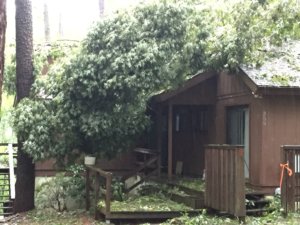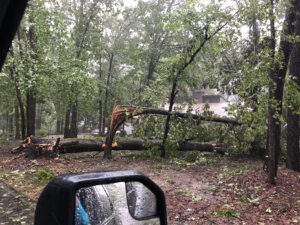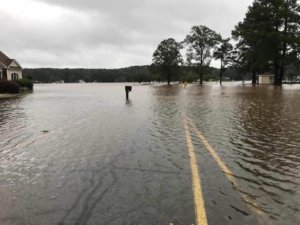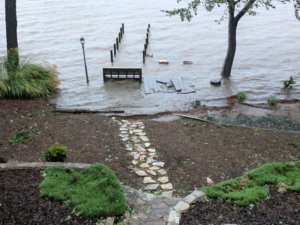The following is a . . .
Special Report from North Carolina
It’s from one of our readers in North Carolina. Sparky Wilson was a guest author a Emergency Plan Guide a couple of years ago, so when Florence hit I knew he was in the affected area. I wrote and was gratified (and pretty amazed!) to get back this detailed assessment of what he and his fellow CERT members have been going through.
I’ve attached some of his photos from the area, too.
You will see that the report suggests a number of ideas for building your team. I’’ll be developing some of them in future Advisories.
In the meanwhile, read on . . .!
Wednesday, September 19, 2018
Virginia, here’s some hurricane news from the Sandhills of central North Carolina! My wife and I live in Carolina Trace, a gated community of 3,000+ people living in 1,750+ homes, situated on 2,500 acres of heavily forested rolling hills with a 330-acre lake in the middle of the community. It is both beautiful and a challenge when disasters hit – like hurricanes, tornadoes, wildfires, chemical spills, heavy rains, and snow and ice storms.
 Hurricane Florence is the second hurricane our CERT has been involved with. Two years ago, we were activated for Hurricane Matthew – high winds, heavy rain, over 500 downed trees and some damaged homes. We learned a lot from the Matthew experience and identified areas where we could improve performance.
Hurricane Florence is the second hurricane our CERT has been involved with. Two years ago, we were activated for Hurricane Matthew – high winds, heavy rain, over 500 downed trees and some damaged homes. We learned a lot from the Matthew experience and identified areas where we could improve performance.
I would like to share some of the lessons we have learned.
I am convinced CERT should . . .
Create Emergency Operations Plans for their neighborhood(s) and coordinate them with key players. The key players include, but are not limited to: the emergency services office, fire department, ambulance service, local shelter, HOA/POA(s), power, water and sewage connection points, and the agency charged with evacuating residents.
 Coordinate frequently with the organization directing your team. Our team reports to the Director of Emergency Services. Learn who else will be out there responding and what can they do for you and vice versa. There are many organizations in your community that will be operating during a disaster response – EMS, fire departments, Red Cross, law enforcement, neighborhood security forces, transportation agencies, Baptist Men’s Group, and the list goes on. You’re going to see them all when the disaster strikes – get to know them now.
Coordinate frequently with the organization directing your team. Our team reports to the Director of Emergency Services. Learn who else will be out there responding and what can they do for you and vice versa. There are many organizations in your community that will be operating during a disaster response – EMS, fire departments, Red Cross, law enforcement, neighborhood security forces, transportation agencies, Baptist Men’s Group, and the list goes on. You’re going to see them all when the disaster strikes – get to know them now.
 Good radio communication is extremely important and never seems to go the way you want. Carolina Trace CERT issues a MURS radio (short-distance Multi-Use Radio Service, limited to 2 watts power) to every team member. It’s our go-to radio for intra-team operations because they are relatively inexpensive, we can add more powerful antennas for increased range and there is no licensing requirement. We encourage our CERT volunteers to become Amateur “Ham” radio operators. Ham radios are great when it comes to reaching out to others in an emergency.
Good radio communication is extremely important and never seems to go the way you want. Carolina Trace CERT issues a MURS radio (short-distance Multi-Use Radio Service, limited to 2 watts power) to every team member. It’s our go-to radio for intra-team operations because they are relatively inexpensive, we can add more powerful antennas for increased range and there is no licensing requirement. We encourage our CERT volunteers to become Amateur “Ham” radio operators. Ham radios are great when it comes to reaching out to others in an emergency.
(Note though that Amateur Radio Operation requires licensed operators so plan ahead. We are fortunate in that we have a narrow-band digital radio that allows us to communicate directly with the Emergency Operations Center (EOC) and our fire department wherever they are in the County.)
Know your team’s strengths and weaknesses. We have learned a lot about our strengths and weaknesses during exercises and especially during Hurricane Matthew. We have worked hard since Matthew to improve our capabilities in those areas where we found weaknesses while maintaining proficiency where we were already to standard. Our field exercises have garnered recognition from our first responders and has led to more training with and from them, thus creating good communications and a better understanding of roles and capabilities for us and them.
 We were prepared when the cone of uncertainty indicated we were at risk. Florence brought us tropical storm force winds and fifteen to twenty inches of rain (depending on where you lived in the County). Some homes were damaged, many trees were toppled and several roads are still impassable due to flooding. We offered support to the county shelter and checked on neighbors when it was safe to venture out. We also provided damage assessments to the fire department and the county Emergency Operations Center.
We were prepared when the cone of uncertainty indicated we were at risk. Florence brought us tropical storm force winds and fifteen to twenty inches of rain (depending on where you lived in the County). Some homes were damaged, many trees were toppled and several roads are still impassable due to flooding. We offered support to the county shelter and checked on neighbors when it was safe to venture out. We also provided damage assessments to the fire department and the county Emergency Operations Center.
Next steps in our CERT response in Hurricane Florence
Carolina Trace clearly “dodged the bullet” when Florence dipped South and skirted us. That said, our preparations through hands-on monthly training sessions and radio checks, field exercises and partnerships with the professionals have led our team members to feel confident in knowing how and what to do when disaster strikes. They understand that If things don’t go well in training they are not likely to go well when it’s for real. Our next step is to conduct a Hot Wash (AAR – After Action Report) to identify areas where we can do better and focus future training on those areas.
Virginia adds: You can see that Carolina Trace has a pretty well organized neighborhood CERT team, with a history of training, connections with local officials, current equipment, etc. Not every community has this level of neighborhood commitment and support, but it is something we can all aim for. A team of trained volunteers in our neighborhoods could make all the difference in how we get through any emergency.
Thanks to Sparky for this timely and valuable information. Please share it — and share YOUR story, too. This is how we know what’s really going on.
Virginia
Your Emergency Plan Guide team
P.S. If you liked this Advisory, sign up below to get one every week. Disasters aren’t going to stop coming.
Don't miss a single Advisory.
Thank you for subscribing.
Something went wrong.
